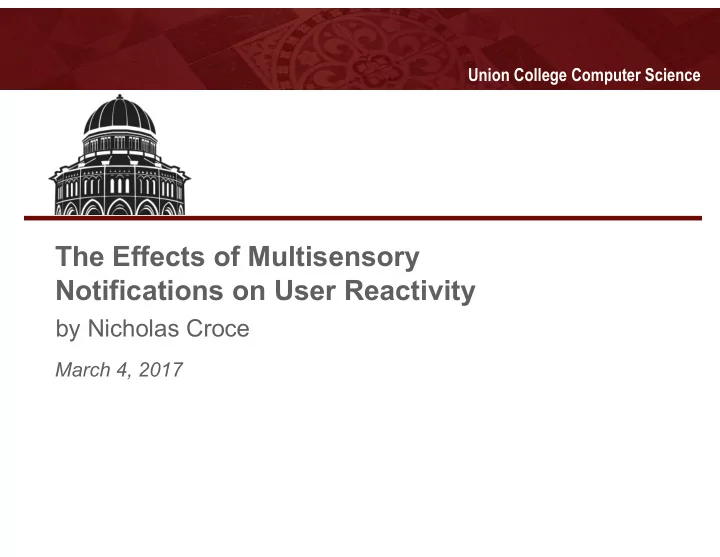

Union College Computer Science The Effects of Multisensory Notifications on User Reactivity by Nicholas Croce March 4, 2017
Title Explained... “Unisensory” Notifications ● Present users with either auditory or visual stimulus. “Multisensory” Notifications ● Present users with both auditory and visual stimuli.
Mobile Application Notifications Typical Notifications ● Limited by the capabilities of a mobile device or Operating System Alarm Clock Notifications ● Limited to device’s sound output as the only method to wake Figure 1. Typical notifications sent from sleeping users iOS applications.
SmartAlarm Multisensory and Unisensory Alarm Clock Application ● SmartAlarm users are given the choice between a multisensory or a unisensory alarm clock experience. Figure 2. SmartAlarm’s app icon.
SmartAlarm Philips Hue Lightbulbs ● Programmable on iOS and Android ● Open-source API ● RESTful Interface over HTTP 1 Figure 4. Flowchart of the Philips Hue system.
SmartAlarm Figure 3. “My Alarm” Scene Figure 4. “My Lights” Scene
Daylight Simulation Figure 5. Linear light incrementation implemented in SmartAlarm 2
Usability Study Logistics ● Conducted over a 6 week period - 4 days per week. ● Total of 34 participants. ● Participants spent two days waking with a multisensory notification, two days waking with a unisensory notification. ● One preliminary survey ● Internet-based, morning-time surveys ● Participants were ensured that their anonymity would be protected in data collection and analysis.
Usability Study Metrics Recorded ● Original alarm time ● Reaction time (when the user actually got out of bed) ● Number of times “snooze” was pressed ● Level of comfortability waking with SmartAlarm (1 to 5) ● Level of morning-time grogginess (1 to 5) Preliminary Sleep Habits Survey ● Measured participants’ Sleep Quality Index (SQI) 3 ○ Takes 8 sleep pattern-based factors into account to measure sleep habits
Sleep Habits vs. Reactivity? Sleep Quality Index (SQI) ● Measures 8 sleep-pattern based factors ● Each factor measured on a scale of 0 to 2 ● The measurements are added up to calculate the SQI ● “Good” sleepers : SQI of 0 - 5 | “Average” sleepers : SQI of 6-10 | “Bad” sleepers : SQI of 11 - 16 Table 1. Sleep Quality Index Factors and Metrics 2
Challenges and Limitations Technology Limitations ● Philips Hue technology requires an ethernet port for lightbulb access and manipulation ○ Participants were therefore limited to Union College Seniors living in off-campus houses ● SmartAlarm light access requires wireless network connection Usability Study Challenges ● Not a laboratory test - no direct observation ○ Participants are trusted to complete the given instructions ● Limiting independent variables (i.e. outside light exposure, bedroom arrangement, lamp placement, etc.) ● Grogginess may be a relative measure ● Time Constraint
Results - User Reactivity Notification Type vs. Reactivity Quick Avg. Slow Reactions Reactions Reactions Multi- ~35% ~56% ~9% sensory Uni- ~29% ~53% ~18% sensory
Results - Snooze Notification Type vs. Snooze Usage 0 1 2 3 4 5+ Multi- ~41% ~27% ~24% ~4.5 0% ~3% sensory % Uni- ~29% ~39% ~14% ~9% ~4.5% ~4.5 sensory %
Results - User Comfortability Notification Type vs. Comfortability 1 2 3 4 5+ Multi- ~3% ~6% ~39% ~42% ~9% sensory Uni- ~3% ~3% ~29% ~42% ~23% sensory
Results - Grogginess Notification Type vs. Grogginess 1 2 3 4 5+ Multi- ~11% ~47% ~26 ~12% ~4.5% sensory % Uni- ~16% ~23% ~38 ~18% ~4.5% sensory %
Results - Grogginess with No Snooze Notification Type vs. Grogginess with No Snooze Presses 1 - 2 3 - 5 Multisensory 68% 32% Unisensory 42% 58%
Most Significant Takeaways Daylight Simulation and Grogginess ● 26% more users noted low grogginess with daylight simulation when they did not press the snooze button Notification Type vs. Snooze Usage ● Users are 10.5% more likely to use snooze 3 or more times with unisensory notifications ● Users are 12% more reluctant to press snooze with multisensory Notification Type vs. Reactivity ● Users are 6% more likely to have quick reactions when presented with multisensory notifications, 9% more likely to react slowly with unisensory notifications Notification Type vs. Comfortability ● Users are 14% more comfortable with using unisensory notifications, compared to multisensory notifications.
Questions...
Recommend
More recommend